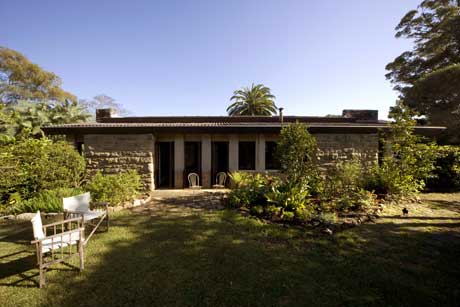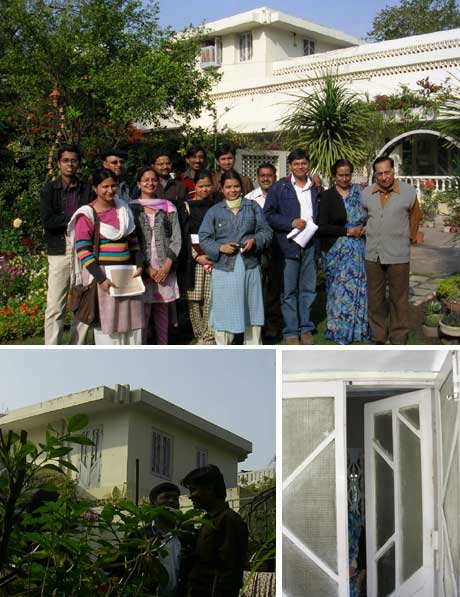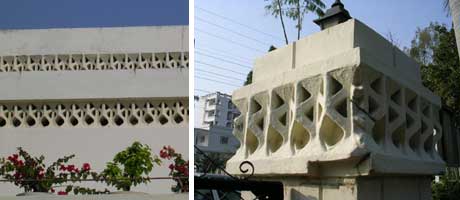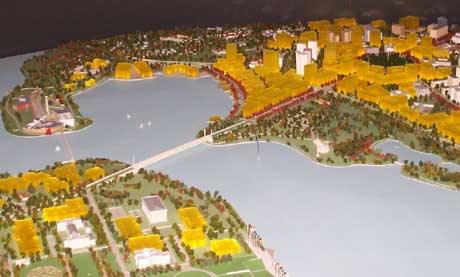Winter House nominated for listing on the State Heritage Register
The Walter Burley Griffin Society Inc is very pleased that the Heritage Council of NSW intends to consider listing the Winter House (also known as Redstone) on the State Heritage Register. The Society fully supports listing the Winter House designed by Walter Burley Griffin and completed in 1935. It is a house of outstanding significance.
The Winter House is one of the most significant 20th century houses in western Sydney, and as the Heritage Branch’s nomination report states it has “exceptional intactness and integrity” retaining all its original interiors, fixtures and fittings. It is “the last Griffin house still remaining in the ownership of the family who commissioned it. “The family is praised highly in the report “for having employed high quality heritage advice in its maintenance and repair since the 1970s, ensuring that it has been conserved according to Burra Charter principles.”
“Redstone remains almost unaltered in its structure and layout” and “is of State heritage significance for its aesthetic qualities as a fine work of architecture and an outstandingly intact example of Walter Burley Griffin’s small-scale house design. It contains many of the features for which Griffin is highly regarded including open planning, juxtaposition of robust stonework with fine oiled timber joinery. … The gracious garden retains trees and other species planted by the original clients and its design has been largely unaltered since 1953.”
The house is an example of Griffin’s development of Prairie School principles that had their origin in the landscape-inspired houses of the early modern movement in Chicago. The house is sited on a rise in the Parramatta valley and has long views to the Blue Mountains, and responds to the broad, open site of the undulating Cumberland Plain at Dundas.
Further details on the nominated item, and making a submission (submissions close 19 November 2008) can be viewed at
www.heritage.nsw.gov.au/listing
Due to the generosity of the owners, more than seventy people enjoyed viewing the Winter House, its beautiful grounds and wonderful intact interiors on Sunday 26 October 2008. The Society’s twentieth AGM was held in the garden with heritage architect Ian Stapleton as guest speaker who spoke on the recent restoration work.
The Magic of America published online
The Art Institute of Chicago has made Marion Mahony Griffin’s great work The Magic of America available online. This is a very great achievement by Ed Fishwick, Mary Woolever and other staff at The Art Institute of Chicago – and above all, a very great day for Marion, as after almost 60 years her work is now available worldwide.
To quote from the website: “The Magic of America a typescript of over 1,400 pages with approximately 650 accompanying illustrations, was written and compiled by Marion Mahony Griffin (1871-1961), architect, designer, delineator, and artist. In 1911 she married Walter Burley Griffin (1876-1937), architect, landscape designer, and city planner. Their architectural practice spanned almost four decades on three continents, and The Magic of America was meant, in part, to be a testament to their life and work together.
The Magic of America: Electronic Edition was launched on 28 August 2007, and collates in a digital format all the texts and illustrations from the three known copies of the work. The electronic edition thus represents the most complete and accessible version currently available of this important architectural document.”
The Magic of America: Electronic Edition is available at
http://www.artic.edu/magicofamerica/
Financial interests prevail over democracy and the Griffin legacy.Senate debate on the Griffin Legacy Amendments to the National Capital Plan
The inadequate consultation process over the momentous amendments to the National Capital Plan culminated on 10 May 2007 in the Senate. Senator Bob Brown’s Motion of Disallowance of four major amendments (Amendments 56, 59, 60 and 61, inappropriately called the “Griffin Legacy Amendments”) formulated by the National Capital Authority came before the Senate on that day.
In his speech introducing his Motion of Disallowance, Senator Brown stated principles and fears, principally on grounds of democracy and the role of the Senate in reviewing Executive responsibility.
Given the intensive efforts from many quarters to lobby all Senators over the issues, the debate and ensuing vote indicated nearly universal disinterest of federal parliamentarians from the two major parties in their national capital.
Particularly notable was the admission by ACT Senator Lundy (then Deputy Chair of the Parliamentary Joint Standing Committee) that the JSC was misled by the National Capital Authority. Instead of a normal inquiry they opted to have a short reference one-day roundtable hearing, only to be surprised and astounded by the passion, depth and spread of informed and expert objections to the Amendments manifested at the roundtable. This was reflected in the committee’s critical report (March 2007). Lundy castigated the NCA saying “serious questions should be asked about how their so-called thorough consultation” was really carried out. However Senator Lundy stopped short of supporting the recommendations of the JSC, of which she was part.
Remarkable was ACT Senator Humphries’ absence from the debate, and also from the vote. There were only 7 votes in favour (4 Greens and 3 Democrats) of Senator Brown’s motion to disallow the Amendments. In a stirring final speech Senator Brown spoke of the “magnificence of this green capital” and referred to the need for more reflection over the Amendments, and to the grave risks in not incorporating rules and guidelines. He also raised doubts about the lower tiers of regulation being able to protect and ensure a sustainable Canberra, and concerns about the limited assessments and public participation and the scope for vested interests to prevail over vision and principles.
Further information
Senate Official Hansard transcript of debate, Thursday 10 May 2007. Refer to pages 22 to 33 for Senator Bob Brown’s speech and the debate. www.aph.gov.au/hansard/senate/dailys/ds100507.pdf
Albert Hall public meeting of 24 May 2007
On the evening of 24 May, in response to mounting public concern over the NCA’s Draft Amendment 53, more than three hundred people attended a very successful meeting to discuss the future of the Albert Hall and its precinct. Among the speakers were the Convenor of the Friends of the Albert Hall, Dr Lenore Coltheart, the co-ordinator of the meeting, Di Johnstone, WBGS Committee member, Rosemarie Willett, Head of the ACT Heritage Unit, Dr Michael Pearson, ACT Senators Garry Humphries and Kate Lundy, ACT Planning Minister, Andrew Barr, and NCA Chief Executive, Annabelle Pegrum.
The main focus of the Meeting was on two separate, but related, issues:
1. The conservation and use of the Albert Hall; and
2. The proposals in the NCA’s Draft Amendment 53 to the National Capital Plan for the redevelopment of the Albert Hall’s ‘precinct’ stretching from the Hall to the Lake shore both to the west and to the north, as far as the southern approach to the Commonwealth Bridge.
With respect to the Hall itself, which is currently managed by the ACT Government, the meeting overwhelmingly rejected (in Resolutions 4 and 6) the latter’s premature attempt to privatise the Hall by calling for tenders for its management and upkeep before agreement had been reached about its use and the future of its precinct. The grounds for these resolutions were (a) that a private manager would not be able to fund the outlays of $1 million plus needed to restore and refurbish the Hall and (b) that such a manager would naturally lease the Hall to high rental commercial clients to the exclusion of the many less affluent cultural groups which had hitherto hired the Hall. The meeting was informed that, in an effort to resolve the problem of the financial responsibility for the Hall, the ACT Government had just announced that it intended to suggest to the Commonwealth Government that the building should be nominated for National Heritage listing.
With regard to DA53, dealing mainly with the Albert Hall precinct, there was a collision between the meeting and the NCA, reflected in the near unanimous resolutions 1 and 2 that DA53 should be withdrawn and that fresh planning and consultation processes should be instituted via a joint body set up by the Federal and ACT Government with ‘equal community representation’. This was at odds with an NCA proposal on the eve of the meeting that, because of changes which had already been made to DA53 (most notably the scrapping of a proposed ‘landmark’ eight storey building adjacent to Commonwealth Bridge), the amendment would be ‘re-released’ after further consultations and workshops ‘in the near future’. The determination of the meeting to restart the planning process from scratch was inspired by the view of the overwhelming majority:
(i) that the NCA’s commercially-slanted proposals would hamper the restoration of the Albert Hall precinct as a community cultural centre;
(ii) that DA 53 flouted the principles laid down by Walter Burley Griffin for the plan of the symbolic central areas of the National Capital’ (Resolution 5);
(iii) that the closure of the clover -leaf road system at the southern end of Commonwealth Bridge, upon which DA 53 was premissed, would cause unacceptable peak-hour traffic congestion in the Parliamentary Triangle and Commonwealth Avenue; and
(iv) that the NCA was currently only prepared to consult about the details of DA53, as opposed to its underlying merits or demerits.
Dr Bruce Kent, 28 May 2007
Further information
Albert Hall resolutions.pdf (48K)
Albert Hall talk Rosemarie Willett.pdf (40K)
ACT Government Media Release 24 May 2007
www.chiefminister.act.gov.au/media.asp?media=2571§ion=24&title=Media%20Release&id=24
Griffin Society wins prestigious award for its website
The Walter Burley Griffin Society website has won the 2007 Energy Australia National Trust Heritage Award for Interpretation and Presentation, Community Groups. The National Trust awards have been described as the ‘Oscars’ of the heritage world.
Meredith Burgmann, President of the Legislative Council, and ABC broadcaster David Marr presented the awards at the Westin Hotel in Sydney on 12 March 2007.
The website, which went live in mid 2006, promotes a greater understanding and appreciation of the work of Marion Mahony Griffin and Walter Burley Griffin and encourages the conservation of their extensive work. It contains thirty-five sections covering the lives and works of Walter and Marion Griffin, the influences that shaped their work and an impressive photo gallery. These were written and designed by members of the society with expertise in various fields. The site also contains downloadable student activity sheets for primary and secondary school teachers.
In selecting the Griffin website for the award, the judges said: ‘It is an impressive achievement from a community-based organisation, about important 20th century architects. It deals with their work both in Australia and overseas.’
The informative heritage site also received praise from members of the community. Scott Robertson, an architect and member of the National Trust’s Urban Conservation Committee said: ‘it is still one of the best, most useful websites I have seen and used. A model of what information websites should be’.
The use of the internet and the electronic media is becoming an important tool in conservation. Tina Jackson, Executive Director of the National Trust of Australia said: ‘Just as heritage may be intangible — much more than just bricks and mortar — we must use electronic communication to get the heritage conservation message across to new and wider audiences.’
Adrienne Kabos, the committee member of the WB Griffin Society who oversaw the development of the website, said: ‘the website is the work of a team of 30 people and this award is a very nice acknowledgment of their expertise and commitment’.
Congratulations go out to all those in the community involved in the project.
Jacqueline Levett
Griffin and Modernism in Lucknow 1930-1970 Architectural seminar, Integral University, Lucknow, India
The Cultural Heritage Educational Initiative was established in 2002 by Mary Kay Judy and local educators in Lucknow, Uttar Pradesh, India to promote local preservation through education and greater public awareness.
Griffin and Modernism in Lucknow: 1930-1970 held in March 2007 was the first seminar to focus on the concept of Modernism as heritage. The majority of students were practising professionals and architectural faculty members in Lucknow. The seminar began with a study and investigation of the career of Walter Burley Griffin in Lucknow in the 1930s.
Before leaving the classroom for field work, students learned about Griffin’s early career in America at Frank Lloyd Wright’s studio and his years in Australia after he and his wife, Marion, won the competition to design the new Federal Capital, Canberra, in May 1912. Griffin initially went to Lucknow in 1935 to design the University Library. He also designed the United Provinces Agricultural and Industrial Exposition grounds and buildings, a series of commissions for private residences and the Pioneer Press newspaper building. Unfortunately, most of these buildings and his legacy in India have been lost to history.
When Griffin was introduced in the seminar, most students were unfamiliar with his work, connection to Wright, or his role in local Lucknow architectural history. Using archives from the Avery Architectural Library in New York City of the original Exposition plan, renderings and drawings of his commissioned work in Lucknow, and donated copies of Two American Architects in India: Walter B. Griffin and Marion M. Griffin 1935-37, by Paul Kruty and Paul E. Sprague, the class sought to find any remaining evidence of his work and retrace his career through the city.
The Bhatia House was visited by Mary Kay Judy and the students as part of the seminar program. The house was designed by Griffin for Bir Bhan Bhatia a professor of science from Lucknow University. Dr Bhatia’s descendents still live in the house which is rapidly being surrounded by high rise apartments.
Griffin’s work and local contributions became a starting point for analysing early Modernism in Lucknow followed by a critical analysis of the thirty most significant local Modernist buildings dating from 1930-1970, identifying many works by significant Indian architects such as Achyut Kanvinde. During the seminar, international organisations that promote preservation of the Modern Movement were introduced, such as DoCoMoMo and the World Monuments Fund, and the work of the Walter Burley Griffin Societies in the United States and Australia.
Bhatia House with participants of the Griffin and Modernism in Lucknow seminar with, at right, the Bhatias, owners of the house and descendants of the original Dr. Bhatia, Griffin’s client. Upper storey detail. Front porch door. Photographers: Participants of the seminar, courtesy Mary Kay Judy
Details of the Bhatia House parapet and gate post at street. Photographers: Participants of the seminar, courtesy Mary Kay Judy
Canberra's Griffin legacy under threat
The issue
Central Canberra and the foreshores of Lake Burley Griffin are poised to be developed with high rise and high density containing excessive residential and commercial space. Such detrimental development would be irreversible and permanent.
Four major amendments to the National Capital Plan formulated by the National Capital Authority (NCA) will come into force unless they are disallowed by Parliament on 10 May.
The Amendments contain no urban design controls to ensure quality urban landscapes and architecture, and show no regard for accepted principles of sustainable city planning.
The Walter Burley Griffin Society is concerned that Griffin’s name has been wrongly used to advance mediocre outcomes that will compromise Canberra forever.
Although called ‘The Griffin Legacy Amendments’, they fail to reflect Griffin’s ideals and intent for urban vitality, diversity, landscape design, sustainability nor a community friendly city. Instead the Amendments, if carried out, would perpetuate the Canberra syndrome of isolated buildings, and dominance of the car, and introduce large areas of high-rise buildings that would dominate the landscape of the ‘Bush Capital’.
Recent history
On 6 December 06, in a break with convention, the Amendments were tabled in both Houses of Parliament prior to the Australian Parliament’s Joint Standing Committee on the National Capital & External Territories (JSC) commencing its own inquiry.
On 23 February 07, the JSC held a roundtable public hearing into the four Amendments to the National Capital Plan proposed by the NCA. Senator Ross Lightfoot, the Chairman of that Committee stated that: “The Griffin Legacy amendments are some of the most significant and far-reaching changes to the National Capital Plan ever undertaken.”
On 22 March 07, the JSC Chairman Senator Lightfoot and his committee of Senators and Members of the House of Representatives published its 80-page report, including a recommendation that the Griffin Legacy Amendments be disallowed so that the NCA has the opportunity to refine the Amendments. As Senator Lightfoot stated “This fine tuning is necessary and in the interests of Canberra and the nation”.
On 28 March 07, the Leader of the Australian Greens, Senator Bob Brown, gave notice of motion that the four Amendments be disallowed. The motion is set to come before the Senate on 10 May.
Let the Senate know that you care about your National Capital and don’t want it damaged by these Amendments. Contact Senators and request their support for Senator Brown’s disallowance motion. Tell them that you support the recommendations of the Joint Standing Committee and that you want the NCA to refine the Amendments, and properly consult the community and experts.
Individual Senators can be identified for specific appeals and their email or other contacts obtained from www.aph.gov.au/Senate/senators/index.htm or just address to Parliament House, Canberra.
Key potential players include:
Senator Ross Lightfoot
Email: senator.lightfoot@aph.gov.au
Senator Kate Lundy
Email: senator.lundy@aph.gov.au
Senator Trish Crossin
Email: www.aph.gov.au/Senate/senators/homepages/contact.asp?id=7Y6
Senator Kim Carr
Email: senator.carr@aph.gov.au
Senator John Hogg
Email: senator.hogg@aph.gov.au
Senator Barnaby Joyce
Email: senator.joyce@aph.gov.au
Senator KerryO’Brien
Email: senator.obrien@aph.gov.au
Senator Nigel Scullion
Email: senator.scullion@aph.gov.au
Senator Natasha Stott Despoja
Email: senator.stottdespoja@aph.gov.au
Senator The Hon. John Faulkner
Email: senator.faulkner@aph.gov.au
Senator Steve Fielding
Email: senator.fielding@aph.gov.au
Senator Andrew Bartlett
Email: www.aph.gov.au/Senate/senators/homepages/contact.asp?id=DT6
Senator Lyn Allison
Email: senator.allison@aph.gov.au
Senator Gary Humphries
Email: senator.humphries@aph.gov.au
Senator Kerry Nettle
Email: senator.nettle@aph.gov.au
Senator Marise Payne
Email: www.aph.gov.au/Senate/senators/homepages/contact.asp?id=M56
Senator The Hon Brett Mason
Email: senator.mason@aph.gov.au
Senator Penny Wong
Email: www.aph.gov.au/Senate/senators/homepages/contact.asp?id=00AOU
Senator Christine Milne
Email: www.aph.gov.au/Senate/senators/homepages/contact.asp?id=ka5
Senator The Hon Rod Kemp
Email: www.aph.gov.au/Senate/senators/homepages/contact.asp?id=WW4
Senator Robert Ray
Email: senator.ray@aph.gov.au
Senator The Hon Kay Patterson
Email: www.aph.gov.au/Senate/senators/homepages/contact.asp?id=LI4
Senator Chris Evans
Email: www.aph.gov.au/Senate/senators/homepages/contact.asp?id=AX5
Further information
News Update No 45 April 2007, the newsletter of the Walter Burley Griffin Society Inc
NewsUpdate45.pdf (404KB)
Executive Summary of the Walter Burley Griffin Society Inc’s submission to the JSC
Executive summary.pdf (248KB)
Walter Burley Griffin Society Inc’s submission to the JSC
www.aph.gov.au/house/committee/ncet/Griffin/subs/sub1.pdf (2,779KB)
Proof Committee Hansard of JSC roundtable on Griffin Legacy Amendments, 23 February 2007, Canberra
www.aph.gov.au/hansard/joint/commttee/J10021.pdf (568KB)
Amendment 53 for Albert Hall Precinct - more controversy
Hard on the heels of the four Amendments, the National Capital Authority (NCA) announced yet another controversial draft amendment to the National Capital Plan. Called Draft Amendment 53, it applies to a large area called the Albert Hall precinct that extends down to the foreshores of Lake Burley Griffin and is bounded by Commonwealth Avenue, Flynn Drive, and Coronation Drive. This area includes Albert Hall, which has served as a town hall for many years, the Canberra Hyatt Hotel and the open space of the road easements that permit beautiful uninterrupted views of the distant hills and lakeside peninsulas.
Amendment 53 provides for high rise and high density land uses on the southern lakeshore in the Albert Hall precinct. The proposal has been met by strenuous community objections expressed in the media and at a public meeting organised by the NCA at Regatta Point on 22 March .
Reporting on the meeting, the Canberra Times in an article titled “Expert blasts NCA scheme. Leave Albert Hall alone, says professor” on 25 March, stated that the former chair of the ACT Heritage Committee, Professor John Mulvaney, had said that:
“As a major heritage precinct, it should not become cluttered with other structures for which the NCA, in any case, appears to have no designated function”. The Canberra Times article went on to state that Professor Mulvaney “was also critical of an eight-storey ‘landmark’ building, proposed for the western side of Constitution Avenue, which he said was justified at the meeting for providing a balance with the National Library”.
“This suggests that the NCA aesthetic relates to the built environment. It entirely overlooks the alternative aesthetic of the natural environment. “
“At present the majestic landscape stretching to the Brindabellas provides a vista from the bridge, or better still, for viewers from Commonwealth Gardens over the lake. “
In a second letter to the Canberra Times on 28 March, Professor Mulvaney discussed the proposed Immigration Bridge in this precinct:
“The Immigration Bridge has been omitted from consideration in Draft Amendment 53. As it represents a significant factor in transport arrangements and must occupy some of the vaunted open space claimed by NCA, its omission suggests another example of divide and rule processes at work. What impact will this 12 metre plus structure have upon the general vista?
Necessary lift structures for those unable to climb many stairs may bulk the structure at Flynn Drive. It simply is unacceptable procedure to consider the future Albert Hall Precinct without taking this structure into account. Further, the already cramped nature of the museum site may suffer further from the bridge’s impact and from access pathways, not to mention its aesthetic appearance.”
A ‘Friends of the Albert Hall’ group has been established and is collecting signatures for a petition opposing the NCA plans for the Albert Hall Precinct. Further information www.ouralberthall.com
Draft Amendment 53 can be viewed on the NCA website at www.nationalcapital.gov.au and by going to Planning and Urban Design from where a 6.3MB pdf file of it and also a comment form can be downloaded. Copies are available from Regatta Point, and the NCA offices. The time for submissions has been extended from April 13 to May 4.
Luke Wensing, Treasurer WBGS Canberra Chapter





